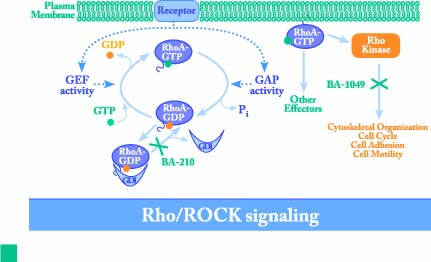The Rho signaling pathway is involved in controlling cell structure and behavior and thus plays an important role in a wide range of indications such as spinal cord injury, glaucoma, traumatic brain injury and brain cancer. By understanding the mechanisms of Rho signaling pathways, BioAxone has been able to block Rho activation at multiple points, leading to a variety of attractive drug targets with a large market potential.
Rho consists of a family of small GTPases which serve a molecular switches involved in the regulation of diverse cellular functions. Switching between activation and inactivation is controlled by three classes of regulators, guanine nucleotide exchange factor (GEF), GTPase-activating protein (GAP) and guanine nucleotide dissociation inhibitor (GDI), as shown in the figure below.
Extracellular signals interact with specific cell surface receptors such as Nogo receptor and tumor necrosis factor receptor and modulate the activities of Rho intracellular regulators. In its inactive state, Rho is GDP-bound. In its active state, Rho is GTP-bound. In neurons, most of the cellular Rho is in the inactivate state. After trauma in the CNS Rho is activated as a result of the release of growth inhibitory proteins and inflammatory mediators that act with neuronal receptors and change the balance of active and inactive Rho. Cethrin inactives Rho to restore the balance to normal. This change in Rho promotes axon regeneration and protects neurons from cell death. In non-neuronal cells, Cethrin inhibits cell migration that is necessary to form the glial scar and Cethrin blocks the invasion of monocytes. Therefore, Cethrin has multiple activities to promote repaire after neurotrauma.


